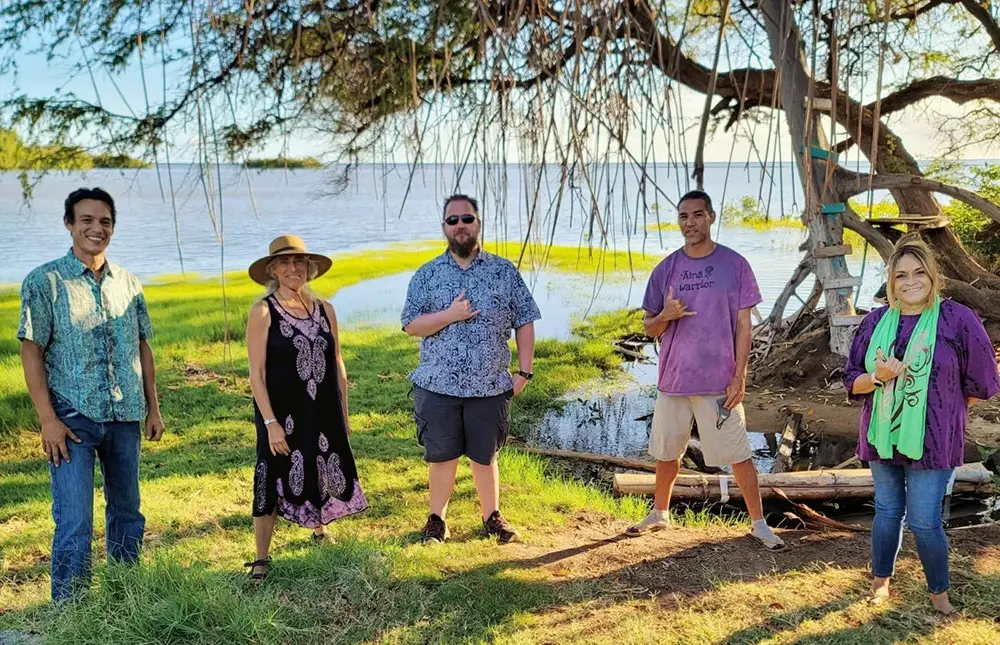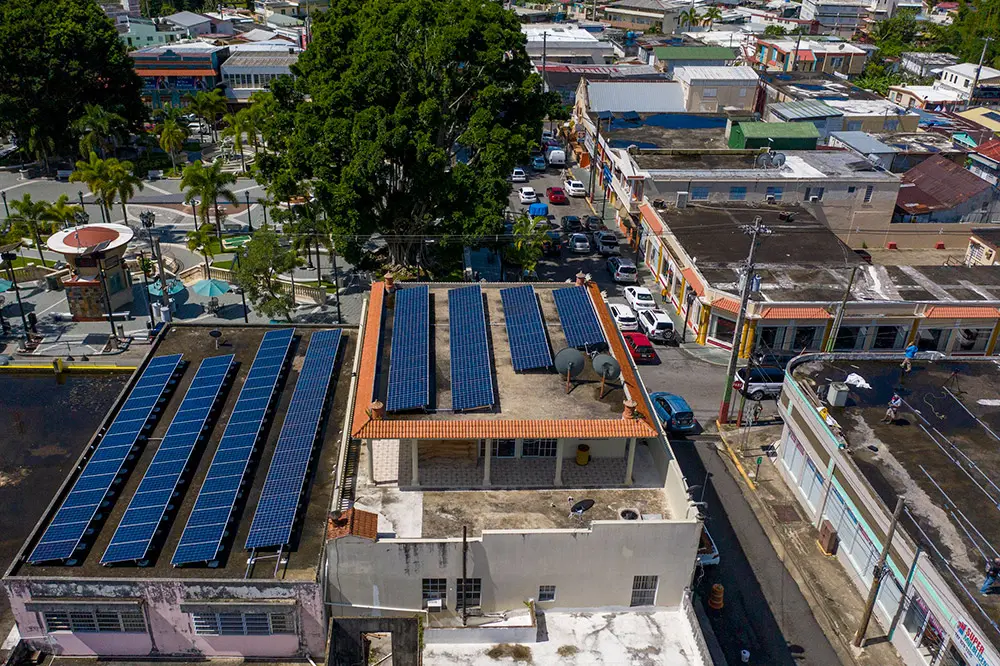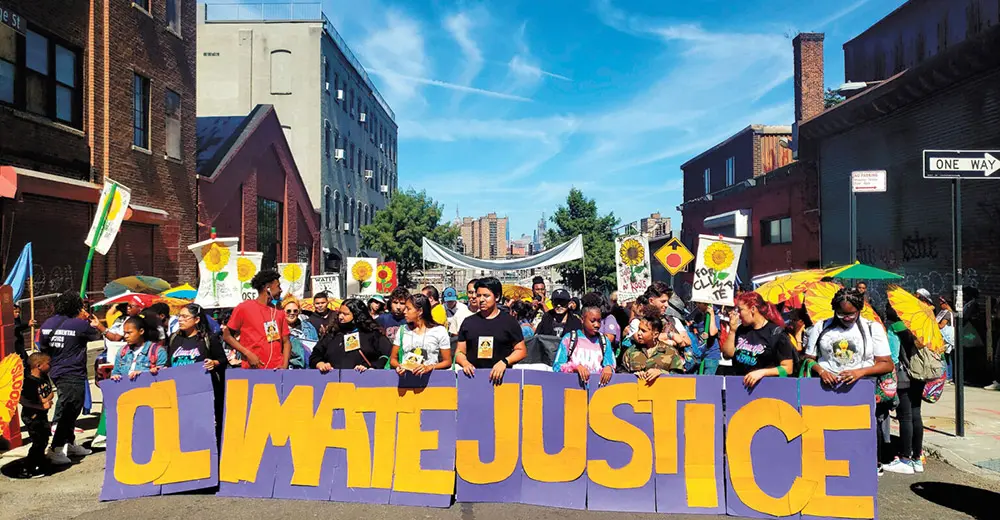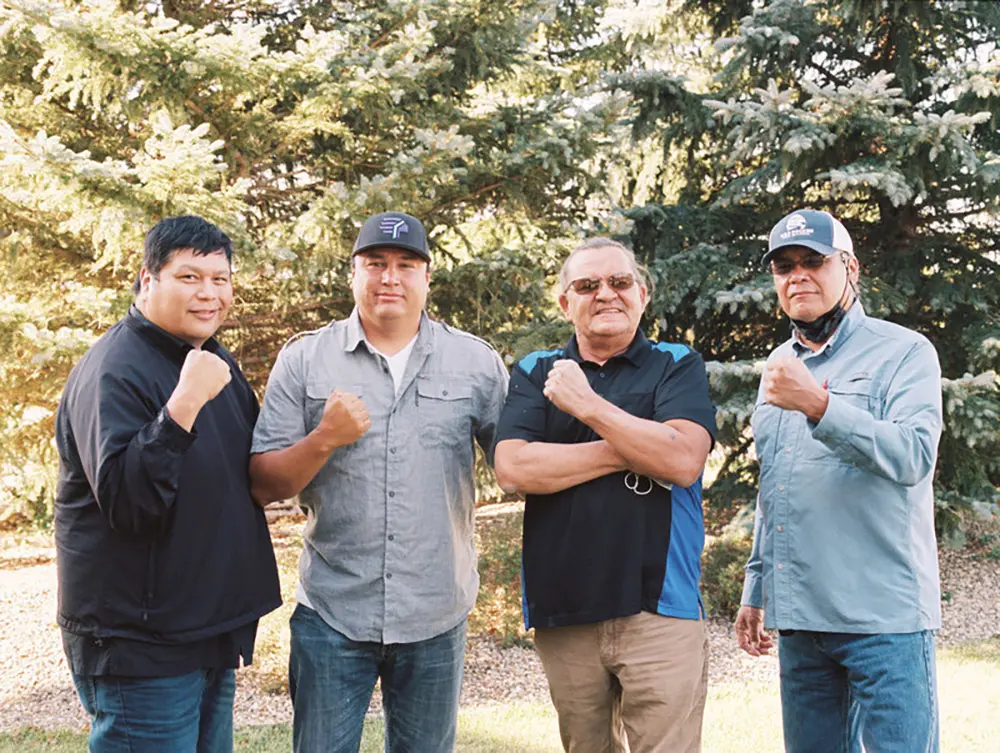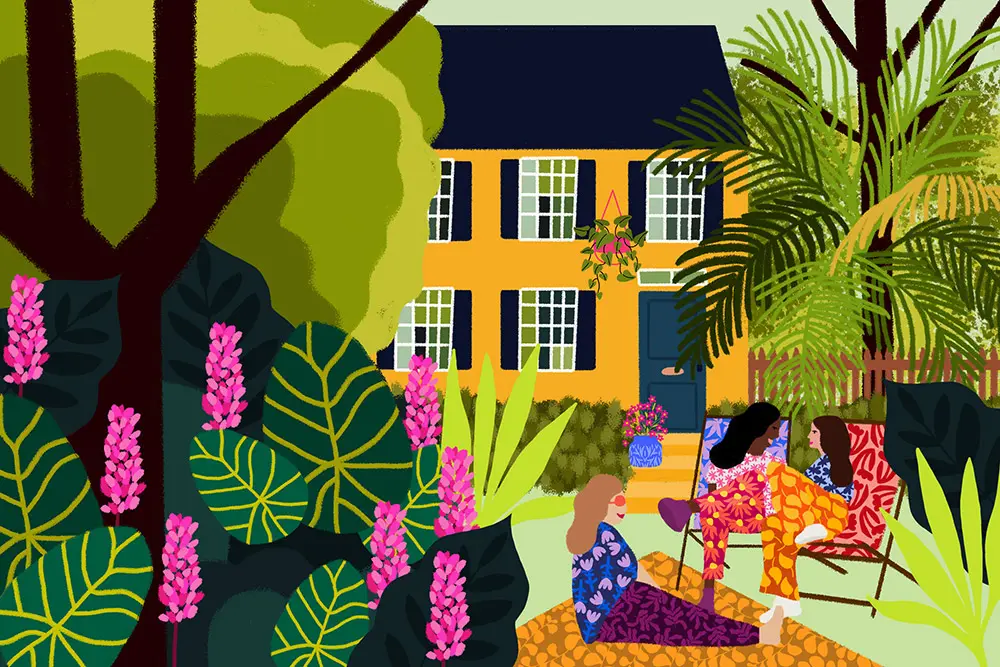Climate resilience as Community-Owned Renewable Energy
Community-Owned Renewable Energy is a powerful tool to:

What it is: Community-owned renewable energy projects, also called people-powered energy projects, differ in size and structure, but they are united by a handful of typical features:
- They are developed, governed, and owned by community members and/or a grassroots group rather than by a large utility company or corporation and their shareholders;
- They are rooted in practices like participatory community planning and democratic decision-making;
- Energy is generated from renewable energy sources, such as solar, wind, hydroelectric, or geothermal, depending on the renewable energy sources available nearby and the types of projects that members want in their community;
- Energy is produced locally and energy systems are community-scale.
People-powered energy projects can also be characterized by some common values and beliefs upon which they are predicated, such as:
- Reliable acess to energy is a basic human need and should be a right, not a privilege;
- Energy systems should align with the environmental, economic, social, cultural and spiritual needs and rights of the community;
- Alternative energy projects should be driven by—and must be accessible and beneficial to—the folks who have been most adversely impacted by historical and current energy systems;
- Economic and racial justice are central to energy democracy work, and vice versa.
Depending on the specific legal and regulatory frameworks of the region, the preferences of the community, and the scale of the project, community-owned energy projects may be structured as cooperatives, community-owned utilities, community renewable energy programs, community choice aggregates, nonprofits, or partnerships between various entities.
Continue readingEnergy democracy is about local communities taking in their own hands the responsibility of building a cleaner and more equitable future. Our communities seek solutions that address the economic and racial inequalities that an otherwise decarbonized economic system would continue to perpetuate. Crystal Huang, founder of People Power Solar and coordinator of the Energy Democracy Project (source)
Some additional context: Amidst an urgent need to transition away from fossil fuels and toward renewable energy sources (read more about that on the fossil fuel resistance page), there also lies an opportunity to rethink how our energy systems are structured, both physically and procedurally. Advocates for a sustainable and just energy future are fighting not just to replace coal, oil, and gas with renewable energy sources like solar and wind but are also calling for the literal and figurative decentralization of power. Climate scholar and activist Ashley Dawson explains, “The energy commons must be about more than simply switching from fossil fuels to solar power: at its heart, this struggle must enable radical redistributions of power that don’t just democratize but also effectively decolonize energy and society.”
Over the past 120 years, the energy industry of the so-called United States has evolved to be largely investor-owned, highly consolidated, and politically powerful. At the turn of the 20th century, investor-owned utility (IOU) companies were clamoring to bring electricity to every building in every city* across the country, and so they looked to wealthy investors to help finance the expansion of electricity systems, which were comprised of massive coal and hydroelectric power plants, high-voltage lines that could transmit power across long distances, and smaller lines that would distribute energy to individual buildings. At the same time, thousands of communities were forming their own public utilities, which were structured similarly to the investor-owned utilities (IOUs) but were not generating profit for private investors. In an attempt to outmaneuver the growing movement for public control over energy, IOUs offered to submit to increased oversight from the state in exchange for industry monopolization.**
By the 1930s, just ten central utility companies controlled 75% of the country’s energy utilities. Not surprisingly, the overcentralized IOUs began price gouging their customers, and so the Public Utility Holding Company Act was passed in 1935 to break up utility monopolies and weaken the influence that utilities held over policy and regulation. The Act was relatively effective until 2005, when George W. Bush bowed to corporate pressure to repeal it, and thus the utility landscape was further consolidated.
While IOUs continue to influence energy policy at the local, state, and federal levels to be hostile to alternative energy models, the movement to return energy ownership, benefits, and decision-making to the people is growing, and community-controlled renewable energy projects offer a path forward.
(*It should be noted that investor-owned utility companies largely failed to serve rural communities. President Franklin D. Roosevelt created the Rural Electrification Administration in 1935 to provide financing for rural electric cooperatives and ensure that rural communities could access electricity, too. As a result, the US currently has over 800 rural electric co-ops serving about 14% of Americans and over 80% of the physical area of the United States.)
(**It should also be noted that the regulation of IOUs was/is not designed to benefit the environment or customers; in fact, quite the opposite! For example, regulators generally designate a set profit margin for new infrastructure, so IOUs are incentivized to double down on building more fossil fuel-powered infrastructure while actively resisting energy efficiency measures and local renewable energy projects that might threaten their profits.)
Continue readingWhy it’s a climate resilience powerhouse:
Divesting from fossil fuel and utility corporations
Community-controlled renewable energy projects allow folks to opt out of traditional energy sources and take control of their energy future. They also contribute to a more diverse energy landscape, helping to challenge the dominance of energy monopolies and weaken their economic and political power. The more that communities organize around energy and advocate for policy supportive of alternative energy models, the more community-controlled renewable energy projects will be able to proliferate and the less control fossil fuel and utility companies will have over energy policy and regulation; it’s a powerful reinforcing feedback loop!
Reducing greenhouse gas emissions and toxic pollution
Community-controlled energy projects have the potential to significantly diminish greenhouse gas emissions and toxic pollution. By displacing fossil fuel-based electricity generation with renewable energy, these projects help to decrease the carbon intensity of the local energy supply. Many community-controlled energy projects also incorporate energy efficiency initiatives, such as retrofitting buildings and implementing energy-efficient technologies, which help to minimize the need for new energy generation and lower associated emissions. Since community-controlled energy projects often prioritize localized energy generation, they also help reduce greenhouse gas emissions and inefficiencies associated with long-distance transmission. Finally, by shifting to renewable energy sources, community-controlled energy projects eliminate or significantly reduce the release of the harmful pollutants associated with fossil-fuel based energy generation, especially for communities located near power plants or fossil fuel extraction sites, which are disproportionately low-income and communities of color. Overall, community-controlled energy projects help to mitigate the climate crisis, improve air quality, and promote environmental justice, benefiting local communities and the planet as a whole.
Continue readingWe face a climate crisis largely because energy in our economy functions as a commodity instead of a life-giving resource. Al Weinrub, coordinator of the Local Clean Energy Alliance (source)
Ensuring that energy systems are reliable, safe, and resilient
Community-controlled energy projects are far better positioned than overcentralized utilities to provide safe and consistent energy access through the extreme weather and disasters ahead. There are already countless examples of large-scale utility companies proving themselves unreliable during moments of extreme weather and major storms; through extreme cold (ex: the Texas power grid failing during Winter Storm Uri), extreme heat and strong winds (ex: commonplace power outages known as “public safety power shutoffs”), hurricanes (ex: Hurricane Sandy leaving many New Yorkers without power for weeks, or Hurricane Maria knocking out power on Puerto Rico for nearly a year), and more. When one thing goes wrong in an overcentralized energy system, the entire system goes down.
Time and time again, utilities neither invest in infrastructure in a way that builds climate resilience nor do they plan for these extreme moments, particularly in BIPOC communities… Furthermore, utilities are also less likely to invest in maintenance for existing infrastructure as building new, expensive systems is a cornerstone of their profit strategy. The Energy Democracy Project (source)
Decentralized systems, where power generation, distribution, and consumption are distributed across multiple smaller-scale units, like small-scale grids or individual buildings, are much more resilient. During and after Hurricane Maria, for instance, many residents reported that their solar-powered homes and community buildings never lost electricity while the rest of the island endured a power blackout.
Large-scale utility infrastructure is also becoming increasingly hazardous as ecological and weather conditions shift (ex: PG&E equipment sparking the deadly Dixie Fire and Camp Fire). When energy production occurs at or near the point of use, however, long-distance transmission networks are rendered unnecessary, therefore eliminating much of the infrastructure that poses a risk during fire-prone conditions (and the dangerous practice of “public safety power shutoffs”).
Since energy is so intertwined with all life-sustaining resources, the impacts of power failures are severe. During a power outage, people often struggle to access basic necessities like clean water, food, and medical care, with disabled folks, elders, and people living in remote areas typically the most impacted. When community-controlled energy projects are able to provide electricity to important community infrastructure (like community centers, schools, hospitals, or even community fridges) during a centralized power failure, the benefits are profound. People-powered energy projects save lives.
Continue readingBolstering the political and economic power of the people
Community-controlled energy projects provide an opportunity to fundamentally change who’s benefitting from energy generation. When comparing community-controlled energy projects to absentee-owned energy projects, the former are more likely to use local materials, borrow from local banks, create good, lasting jobs for community members, and circulate profits within the community. A 2014 report by the Institute for Local Self-Reliance provides a stark example of the contrast; under the ownership of Spanish firm Iberdrola, a 20 megawatt wind energy project built in Minnesota was projected to create about 10 long-term jobs and add $20 million to the state’s economy, but if the same project were owned by Minnesota farmers or a local power cooperative, the wind project was expected to create 20 long-term jobs (double that of Iberdrola) and add as much as $68 million to the state’s economy (more than triple that of Iberdrola). Community-controlled energy projects allow communities to retain the wealth that they’re generating, rather than having wealth extracted from them to maximize shareholder profits.
Also, like all endeavors where folks are collectively governing local resources (like community-controlled housing), community-controlled energy projects provide a forum through which community members can build deep relationships with one another, strengthen their democratic decision-making muscles, hone their ability to share resources and cooperate, develop shared political analyses, navigate community conflict, engage in collective care, and more. These types of projects build grassroots people power.
Continue readingImproving energy access and minimizing energy burdens
Community-controlled energy projects can provide energy at lower, more reliable costs than traditional utility rates. While fossil fuel prices (which impact utility rates) are erratic, and can be influenced by a whole host of global factors, renewable energy costs tend to be stable, if not steadily decreasing, over time. Additionally, community-controlled energy projects are beholden to the needs and desires of their members, not the whims of the market. So, they can adjust prices (and their larger business model) as needed to ensure that energy remains accessible to all. Many community-controlled energy projects are explicitly designed to bridge the energy access gap and reduce energy burdens on low-income and communities of color, who spend an average of 7.2% of their income on utilities as compared to higher-income households, who spend just 2.3%.
Continue readingEnergy Justice is providing energy as an essential human service by cutting out the for-profit part. Ruth Santiago, climate and environmental health activist and attorney
The nuance / caveats:
When getting involved with the people-powered energy landscape, there are some complexities to keep in mind, among them:
- These projects have the potential to be a force for energy democracy and people power. However, new renewable energy projects often fall into the same traps as more traditional energy projects; large-scale, extractive, and beholden to investor returns. Prioritizing liberation, justice, and sovereignty at every stage is so important.
- Renewable energy technology itself can also be extractive and harmful (ex: lithium-ion batteries, commonly used in energy storage systems, require the extraction of lithium, often through unsafe labor conditions and environmentally degrading, depleting, and disruptive mining practices, or large-scale hydroelectric dams, which can transform ecosystems and devastate fisheries). It’s critical that people-powered energy projects prioritize energy sovereignty, meaning that community members have the right and ability to control and determine their own energy systems, and can choose the renewable energy sources that best align with the environmental, economic, social, cultural and spiritual needs of the community. It’s also worth noting that, when communities are accountable for renewable energy projects in their own backyards, they are more likely to make every effort to minimize potential harm to their beloveds, neighbors, and local ecosystems, unlike large-scale, absentee-owned renewable projects.
- Getting a community-controlled renewable energy project off the ground (and sustaining it) is neither easy nor straightforward! In some locations, it can be near impossible. IOUs continue to shape energy discourse and influence energy policy at the local, state, and federal levels to be hostile to alternative energy models. A huge part of this work is organizing to challenge the false narratives that IOUs are pushing (ex: the myth that decentralized energy models threaten the affordability of electricity for IOU customers, and therefore exacerbate racial and economic injustices) and to shift public policies, funding mechanisms, and procurement programs to prioritize community energy. The People’s Utility Justice Playbook is an excellent resource to learn more about this critical work!
- Not all energy democracy advocates are aligned on strategy. Aviva Chomsky explains in her book Is Science Enough, “Energy democracy advocates offer differing scenarios for how democratic control could work. Some emphasize small-scale, decentralized, locally controlled, community-based renewable energy systems. Others believe that economies of scale and existing infrastructure mean we should focus on democratizing large-scale energy projects. Unions caution that, given high levels of unionization in existing energy systems, we must be sure decentralization does not become part of the larger corporate attack on unions.” As long as energy democracy advocates stay grounded in shared values and vigilant about possible repercussions, there’s room for a plurality of strategies in the movement.
Spotlights
Hoʻāhu Energy Cooperative is a community owned and managed energy cooperative in Moloka’i, Hawaii that was formed by community advocates in 2020 to provide a clean, resilient, and more affordable energy option for island residents. The residents of Moloka’i, about 60% of whom are Native Hawaiian, are impacted by a uniquely heavy energy burden; they pay an average of $0.41 per kilowatt hour for electricity compared to the United States average of $0.13- more than triple the country’s average (as of August 2021)! Ho’āhu Energy Cooperative is working to change that. They spent the past few years hosting dozens of public workshops for residents to co-design community solar and battery storage projects, which they are now building in partnership with local, progressive energy developers. The projects are expected to meet the energy needs of about 20% of the island, or about 1500 households, including renters, who comprise about 30% of the island, and who would not otherwise be able to reap the benefits of rooftop solar. President Todd Yamashita explains, “Instead of letting another developer come in and create this major gridscale energy development, we can take the place of the developer and perhaps build a system that best reflects our community and culture.”
You can support Hoʻāhu Energy Cooperative by making a gift here.
Continue reading about Community-Owned Renewable Energy
Soulardarity is a membership-based non-profit in Highland Park, Michigan (a small city in the greater Detroit area). The organization emerged in 2012 from a crowdfunding campaign to raise enough money to install community-owned, solar-panel-charged streetlights in the neighborhood after the area’s utility provider repossessed more than a thousand streetlights when the city was facing a budget crisis. Today, Soulardarity is working hard to advance energy democracy through education, community organizing, and people-powered energy projects, with the goal of one day realizing a future where the community is powered completely by local, resilient, and affordable clean energy resources that are owned by people and businesses in the community. This work is particularly pertinent in Highland Park, where the energy infrastructure is failing (power outages are not uncommon) and where the city’s residents, about 88% of whom are Black and about half of whom live below the federal poverty line, are also impacted by a uniquely heavy energy burden; the average household spends a third to a fifth of their income paying utility bills, which have been steadily rising over the last several years.
You can support Soulardarity by making a one-time contribution here or becoming a monthly sustainer here. You can become a dues-paying member here.
Continue reading about Community-Owned Renewable Energy
New Energy Economy is a New Mexico-based nonprofit that was founded in 2004 to help usher in the transition to renewable energy. Today, they’re working to end fossil fuel use and democratize energy through targeted legal campaigns, policy work, community organizing, and the installation of community-scale solar systems around the state- on public buildings, community organizations, local farms, and tribal lands. They were instrumental in crafting and passing New Mexico’s Community Solar Bill, which allows multiple participants to engage with and reap the benefits from a single solar installation. They were also instrumental in passing the state’s Energy Transition Act, which set ambitious renewable energy standards and established a pathway to close coal-fired power plants, and they’re currently active in defeating bills promoting false climate solutions, like carbon credit markets and carbon capture and storage projects.
You can support New Energy Economy by making a donation here.
Continue reading about Community-Owned Renewable Energy
Casa Pueblo is a community-based organization in the town of Adjuntas, Puerto Rico, that was founded in 1980 to engage in environmental advocacy, reforestation projects, and sustainable development efforts on the island. They began advocating for solar energy about twenty years ago and installed solar panels on its community center. When Hurricane Maria knocked Puerto Rico off the power grid in 2017, Casa Pueblo’s solar system persisted, and their center became an oasis for the community. They distributed thousands of solar lamps around the region and began installing solar systems on shops, homes, and community buildings. They have since led hundreds of community solar projects and have helped turn the municipality of Adjuntas into Borinquen’s first solar town. Casa Pueblo is also leading the #50ConSol movement to rebuild the island’s energy grid with 50% solar energy by 2027, a decade after Hurricane Maria. Executive Director Arturo Massol-Deyá says, “‘50% with Sun’ drives Puerto Rico towards energy self-sufficiency, which is critical for our island, but also for the rest of the globe. We plan to show the world that the transition to solar is possible, right now.”
You can support Casa Pueblo by making a gift via PayPal here.
Continue reading about Community-Owned Renewable Energy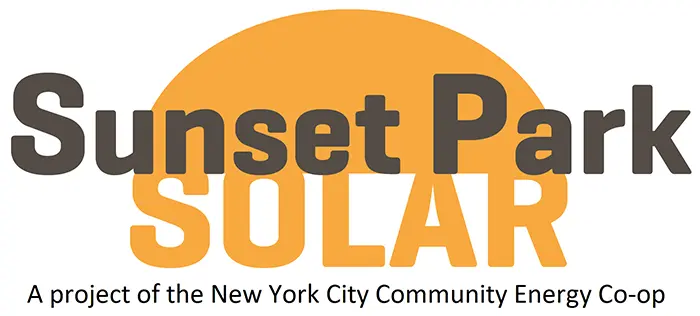
Sunset Park Solar is a community-led solar project in the process of being built on the rooftop of Brooklyn Army Terminal, an industrial campus on the Sunset Park waterfront in New York City. The project is being spearheaded by UPROSE, Brooklyn’s oldest Latino community-based organization (founded in 1966!) and a force for environmental and climate justice, in partnership with a mission-aligned clean energy developer, Working Power. About 200 households and businesses will be able to subscribe to the community solar project and share its benefits, including a minimum of 15% savings on monthly utility bills. Revenue earned through the project will be returned to the community via UPROSE’s Community Resiliency Fund, which subscribers will help to govern.
You can support Sunset Park Solar by making a contribution to UPROSE here. If you’re a Sunset Park resident, sign up here for more information about the project and to explore if you’re eligible to be a community solar subscriber!
Continue reading about Community-Owned Renewable Energy
Indigenous Energy Initiative (formerly known as Indigenized Energy Initiative) is an Indigenous-led organization on a mission to advance energy sovereignty in Indigenous communities, which are disproportionately impacted by energy poverty, unreliable energy infrastructure, the harms of fossil fuel extraction and production, and the climate crisis. IEI was thoughtfully launched on the Standing Rock Sioux Reservation, a site of tremendous Indigenous-led resistance to the expansion of fossil fuel infrastructure. IEI’s co-founder Chéri Smith reflects, “At Standing Rock, our collective voice was saying ‘no’ to more fossil fuels. The [Indigenous] Energy Initiative is giving people something to say ‘yes’ to.” IEI is taking a deeply holistic approach to this work, supporting tribes in all stages of developing their own community renewable energy projects, advocating for sensible energy policy, providing robust clean energy workforce development and training (Smith says, “We’re training a workforce of solar warriors”), and fostering collaboration amongst tribal nations.
You can support Indigenous Energy Initiative by making a donation here.
Continue reading about Community-Owned Renewable EnergyResearch + reflection prompts:
- Which entity are you currently receiving energy from? How is the utility structured? How are they generating power? If it’s an IOU, check out websites FollowTheMoney.org and LittleSis.org to better understand your utility’s influence on politicians and policy. If it’s a rural electric cooperative, research the board members to better understand their values and priorities. Find out when the next board member election is and who’s running.
- Does your state authorize community choice aggregates (CCAs) and/or community solar programs? Are there any CCAs or community solar programs in your region? The Institute for Self-Reliance’s Community Power Map is a great resource to better understand the policy landscape!
- Are there any other emerging community-owned energy projects near you?
How to get engaged:
Battery sharing
If your community is particularly prone to unreliable energy or power shutoffs: Consider teaming up with friends or neighbors to start a battery sharing collective. Portable, solar-powered batteries can be handy, if not lifesaving, amid an energy emergency, but they can also be expensive. Backup battery collectives allow you to spread both the cost and benefits among community members. Check out Shareable’s guide, “How to Start a Back-Up Battery Collective” to get started.
Shift policy & leadership
If you have the passion and bandwidth: Organize to shift policy and leadership in energy decision-making spaces at the local and state levels. Rally around energy democracy champions to get them elected onto local commissions, boards, and legislatures (or consider running yourself!). Organizations like Solar United Neighbors, the Energy Democracy Project, and Sustainable Economies Law Center have an abundance of resources to get started in the fight to make community-owned renewable energy projects truly viable.
Financial support
If you have access to the financial resources: Redistribute funds or invest in community-owned energy projects advancing renewable energy and energy democracy in your region. Use the Institute for Self-Reliance’s Community Power Map available online to find projects near you.
General best practices
Make sure to center those most impacted by social, racial, and economic injustices in your community’s struggle for energy democracy. Check out the People’s Utility Justice Playbook for more best practices and ideas to combat the tactics of investor-owned utilities! To name a few, remember that your lived experience is expertise, invest in leadership development for your community members and popular education to grow your organizing base, develop clear and relatable messaging around the importance of people-powered energy, and prioritize deep, relational organizing and unity-building across movements.
A smattering of resources for continued learning + action:
Short Reads
- “Energy is a Human Right” by Aviva Chomsky in Yes Magazine
- “Toward An Energy Democracy” by Olúfẹ́mi O. Táíwò in New York Magazine
- “Wind and Solar Create More Jobs When They’re Locally Owned, Report Finds” by Kayla Schultz in Yes Magazine
- “Renewable Energy Projects Power Up in Tribal Nations” by Ted McDermott in Yes Magazine
- “How Indigenous Communities Are Building Energy Sovereignty” by Natalie Peart in Yes Magazine
- “The Co-Op Model is Helping Spread Solar to Cities Across the U.S.” by Cinnamon Janzer in Next City
- “‘It’s Not Inevitable That This Will Be Unjust’: A A&A With Shalanda Baker on Energy Justice” by Barbara Moran in WBUR
- “Replacing Fossil Fuels with Community-Led Clean Energy” by Leanna First-Arai in Yes Magazine
- ★ “Power to the People: Why We Need Energy Justice” by Al Weinrub in Nonprofit Quarterly
Guides & Reports
- Energy Democracy: Honoring the Past and Investing in a New Energy Economy by Race Forward, written by Leah Obias and Emi Yoko-Young
- People’s Utility Justice Playbook by The Energy Democracy Project
- A People’s History of Utilities by The Energy Democracy Project
- ★ Reimagining Energy for our Communities zine by Energy Democracy Project
- The Energy Justice Workbook by Initiative for Energy Justice
- Beyond Sharing—How Communities Can Take Ownership of Renewable Power by Institute for Local Self-Reliance written by John Farrell
- Power by the People: Clean Energy from the Grassroots (a series) by Canary Media
- Advantage Local: Why Local Energy Ownership Matters by the Institute for Local Self-Reliance
Long Reads
- ★ Energy Democracy: Advancing Equity in Clean Energy Solutions edited by Denise Fairchild and Al Weinrub
- Is Science Enough? Forty Critical Questions About Climate Justice by Aviva Chomsky
- Revolutionary Power: An Activist’s Guide to the Energy Transition by Shalanda H. Baker
- Solarities: Seeking Energy Justice by After Oil Collective, edited by Ayesha Vemuri and Darin Barney
- The Grid: The Fraying Wires Between Americans and Our Energy Future by Gretchen Bakke, Ph.D.
- Short Circuiting Policy: Interest Groups and the Battle Over Clean Energy and Climate Policy in the American States by Leah Cardamore Stokes
Watch
- We the Power: The Future of Energy is Community-Owned: a 38-minute film by Patagonia about the citizen-led community-energy movement in Europe
- After the Dark: The Movement to Light Up Puerto Rico with the Sun: a 13-minute film produced in collaboration with Google Earth Outreach to highlight the importance of community solar in Puerto Rico after Hurricane Maria, featuring Casa Pueblo
